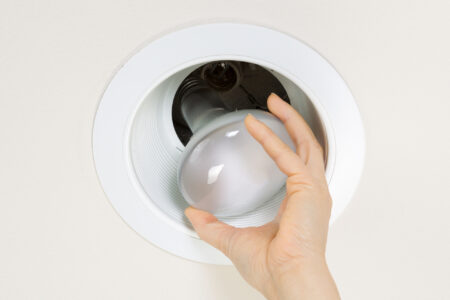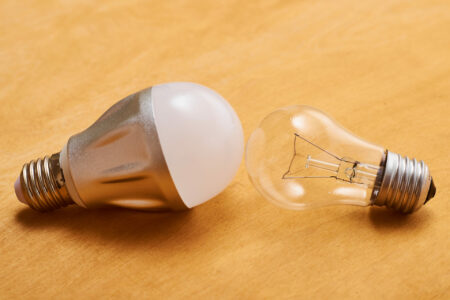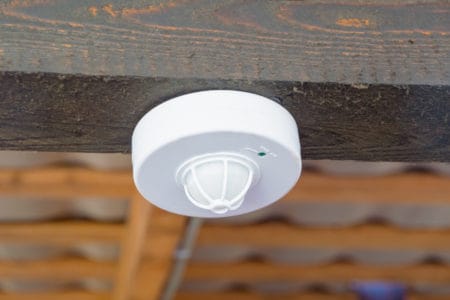Coming across different lighting terms can be confusing. Sometimes A19 and E26 refer to the same thing. However, sometimes they don’t. So what’s the difference between an A19 and E26 bulb? Keep reading to understand the details.
What Is an A19 Bulb?
According to lighting terminology, A19 refers to the shape of the light bulb itself. Obviously, this term consists of two parts: the letter and the number, and it’s essential to know what each part means.
Basically, the letter “A” stands for the word “Arbitrary,” which is the name of the standard pear-shaped bulb we all know. The number “19,” on the other hand, describes the size of the bulb.
Typically, the number referring to the bulb’s size measures the diameter of the glass globe at the widest point. Many numbers used in lighting terminology follow the U.S. standards, meaning they’re usually measured in an eighth of an inch.
Consequently, the diameter of an A19 light bulb equals 19/8, which is approximately 2.4 inches. This isn’t the case in countries using the metric system, though. That’s because, in those countries, they measure the bulb’s diameter in millimeters.
As a result, A19 light bulbs over there go by the name A60, which is the result you get converting 2.4 inches into millimeters. As for the bulb’s length, the standard A19 lamp often measures 100–110 millimeters long.
Standard Dimensions of A19 Bulbs
Different A19 bulbs vary in dimensions by just a millimeter or less. However, these differences determine how much light the lamp produces. Take a look at different wattage options and their equivalent dimension, as governed by the American National Standards Institute (ANSI).
| Wattage | Maximum Length (in Millimeters) | Maximum Diameter (in Millimeters) |
| 100W | 112.7 | 69.5 |
| 75W | 112.7 | 69.5 |
| 60W | 112.7 | 69.5 |
| 50W Type 211 | 112.7 | 69.5 |
| 40W Type 211 | 112.7 | 69.5 |
| 40W Type 210 | 108 | 69 |
| 50W Type 206 | 100 | 68 |
What Is an E26 Bulb?
Unlike the A19 bulb, E26 refers to the type and size of the bulb’s base, not the bulb itself. Therefore, it has nothing to do with the shape or the size of the lamp. This means that you can expect to find many light bulbs with the term E26 over them, but what does it mean then?
The term “E26,” just like “A19,” has two parts. Nevertheless, the first part here describes the mounting method, which, in this case, is an “Edison screw.” Edison screw is the common classic type of bulb base that you screw into the socket.
As for the number “26,” as you probably figured, it measures the diameter of the bulb’s base in millimeters (approximately one inch).
Standard Dimensions of E26 Bases
The standard dimensions of the E26 are typically set by the International Electrotechnical Commission (IEC) under standard 7004-21A-3. In general, the base’s width and height are the same, with just a fraction of an inch difference. As for other measurements, they’re as follows:
- Height of contact point (C): min 3.25 mm
- Width of contact point base (H): min 9.14 mm and max 11.56 mm
- Width of the contact point (L): min 15.24 mm and max 17.01 mm
- Height with solder (T1): min 19.56 mm
- Height without solder (T): min 19.56 mm
- Thread radius (r): 1.191 mm
- Thread height (d1): 24.72 mm
Are A19 and E26 the Same?
Well, sometimes. How so, you ask? Here’s the explanation.
Now that you understand the difference between the two terms, it’s safe to say that almost all A19 bulbs are E26. That’s because, according to the ANSI standards, A19 bulbs manufactured in the U.S. must have E26 bases.
This means that if you have an A19 bulb at your house, which you probably do, it definitely has an E26 base. However, you can’t say it’s the other way around. That’s because bulbs with E26 bases come in all different shapes and sizes, not just A19.
So, next time you go shopping for a light bulb, you’d know exactly what you’re looking for.
What Are the Varieties of A19 Bulbs?
When you think of a light bulb, the first thing that comes to mind is the stereotypical image of an incandescent A19 bulb. This type of light bulb has clear glass with a filament inside that illuminates with the help of an electrical current.
Nonetheless, with the constant need for more energy-efficient options, there had to be other alternatives to the standard incandescent bulb. In this case, they’re the Compact Fluorescent Light bulbs (CFL) and the Light Emitting Diode bulbs (LED).
Here’s a comparison between the three types:
| Incandescent | CFL | LED | |
| Wattage for 1000–1400 lumens | 75W | 18–22W | 12–13W |
| Life Span | 1,200 hours | 8,000 hours | 25,000 hours |
| Benefits | The cheapest | Cheaper than LED | The most energy efficient and longest lasting |
| Downsides | The most energy consuming | More energy consuming than LED and poor color rendering | More expensive than the other types |
What Are the Varieties of E26 Bulbs?
Since E26 is the most common base type in the U.S. In fact, all North American countries, as well as Japan use it too. That’s why people refer to it as a medium or standard base.
Generally, many bulb types come fitted with an E26 base, including:
- Incandescent bulbs
- Globe bulbs
- Vintage bulbs
- CFL bulbs
- LED bulbs
- Halogen bulbs
What Are the Advantages of A19 Bulbs?
Aside from the fact that the A19 light bulb is the most used lamp size in U.S. houses, there are a few other advantages to it, which are as follows:
- Fits in most household fixtures
- Has different options (CFL, LED, and incandescent)
- Produce omnidirectional lighting
- Provides even lighting
- Emits high lumens
What Are the Advantages of E26 Bulbs?
Light bulbs fitted with E26 bases have many advantages. Not only because they’re popular, but also because of the mounting method they use. Here are the best advantages of E26 bases:
- Easy to find appropriate fixtures for them
- Straightforward installation that requires no assembly or special tools
- Secure mounting
- Suitable for places with high vibrations, as the screw threads are rigid
- Moisture and debris-proof, as the tight fit prevents any objects from coming close to the contact point
- Less probability of electrical failures






